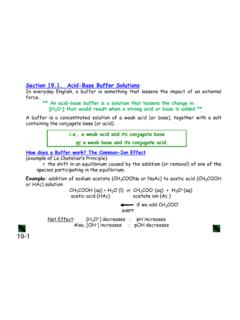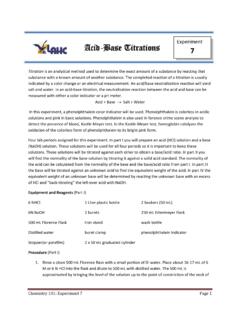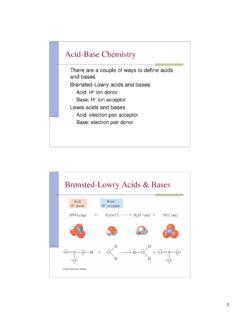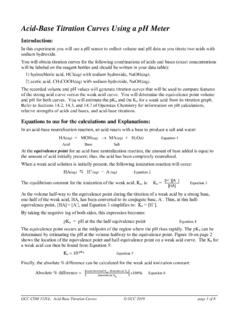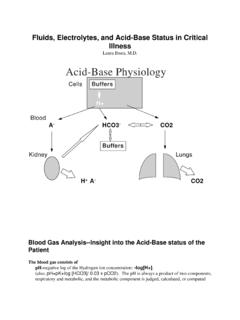Transcription of Fluid, Electrolyte, and Acid-Base Balance
1 2017 Ebneshahidi Fluid, Electrolyte, and Acid-Base Balance Dr. Ali Ebneshahidi 2017 Ebneshahidi Body Fluids A typical adult body contains about 40 L of body fluids. 25 L of fluids (or 63%) are located inside body cells, called intracellular fluid (ICF). 15 L of fluids (or 37%) are located outside of body cells, called extracellular fluid (ECF). 80% of ECF is interstitial fluid (which includes lymph, synovial fluid, cerebrospinal fluid, GI tract fluids, and fluids in the eyes and ears), and 20% of ECF is blood plasma. ICF is mostly water and is rich in K+, Mg++, HPO42-, SO42-, and protein anions. ECF contains more Na+, Cl-, HCO3-, and Ca++. 2017 Ebneshahidi 2017 Ebneshahidi 2017 Ebneshahidi Concentrations of substances dissolved in ICF and ECF are constantly different because the cell membrane is selectively permeable, which maintains a relatively unchanged distribution of substances in different body fluids. Fluid Balance refers to the proper levels of water and electrolytes being in the various body compartments according to their needs.
2 Osmotic pressure (created by the dissolved electrolytes in body fluids) and hydrostatic pressure (created by the water in body fluids) are the main forces behind any molecular movement between body compartments. 2017 Ebneshahidi Exchange of gases, nutrients, water, and waste between the three fluid compartments of the body. 2017 Ebneshahidi Water Balance Water is the most abundant constituent in the body, varying from 45% to 75% of body weight. Water Balance occurs when water intake equals water output. A normal adult consumes about 2,500 ml of water daily 1,500 ml in beverages, 750 ml in food, and 250 ml from cellular respiration and anabolic metabolism. At the same time, this adult is releasing about 2,500 ml of water daily -- 1,500 ml in urine, 700 ml by evaporation (through the skin and lungs), 100 ml in the feces, and 200 ml in sweating. 2017 Ebneshahidi Regulation of Water intake 1. The body loses as little as 1% of its water. 2.
3 An increase in osmotic pressure of extracellular fluid due to water loss stimulates osmoreceptors in the thirst center (hypothalamus). 3. Activity in the hypothalamus causes the person to be thirsty and to seek H2O. Drinking and the resulting distension of the stomach by water stimulants nerve impulses that inhibit the thirst center. water is absorbed through the wall of the stomach, small intestine, and large intestine. The osmotic pressure of extracellular fluid returns to normal. 2017 Ebneshahidi The Thirst mechanism for regulating water intake 2017 Ebneshahidi Events in regulation of water output I. Dehydration: 1. Extracellular fluid becomes osmotically more concentrated. 2. Osmoreceptors in the hypothalamus are stimulated by the increase in the osmotic pressure of body fluids. Hypothalamus signals the posterior pituitary gland to release ADH into the blood. 4. Blood carries ADH to the kidneys. 5. ADH causes the distal convoluted tubules & collecting ducts to increase water reabsorption.
4 6. urine output decreases, and further water loss is minimized. 2017 Ebneshahidi Dehydration 2017 Ebneshahidi ADH 2017 Ebneshahidi Excess water intake 1. Extracellular fluid becomes osmotically less concentrated. 2. This change stimulates osmoreceptors in the hypothalamus. posterior Pituitary gland decrease ADH release. 4. Renal tubules decrease water reabsorption. 5. Urine output, increases and excess water is excreted. 2017 Ebneshahidi Excess water intake 2017 Ebneshahidi Electrolyte Balance Electrolytes are chemical substances that release cations (positively charged ions) and anions (negatively charged ions) when they are dissolved in water. Electrolytes serve 4 primary functions in the body. as essential minerals ( iodine, calcium). control osmosis between body compartments by establishing proper osmotic pressure ( sodium, chloride). help maintain Acid-Base Balance ( hydrogen ion, bicarbonate ion). carry electrical current that allows the production of action potentials ( sodium, potassium).
5 The most important electrolytes include Na+, K+, Cl-, Ca++, and HPO42-. 2017 Ebneshahidi Na+ is the most abundant extracellular cation; involved in nerve impulse transmission, muscle contraction, and creation of osmotic pressure. Cl- is a major extracellular anion; involved in regulating osmotic pressure between body compartments, forming HCI in stomach, and involved in the chloride shift process in blood. K+ is the most abundant cation in ICF; involved in maintaining fluid volume, nerve impulse transmission, muscle contraction, and regulating pH. 2017 Ebneshahidi Ca++ is the most abundant ion in the body, located mainly in ECF; a major structural component of bones and teeth; functions in blood clotting, neurotransmitter release, muscle tone, and excitability of nervous and muscle tissues. HPO42- is an important intracellular anion; another major structural component of bones and teeth; required for synthesis of nucleic acids and ATP, and for buffering reactions.
6 Level of electrolytes are mainly regulated by hormones: Aldosterone (from adrenal cortex) causes an increase in sodium reabsorption and potassium secretion at the kidney tubules. Parathyroid hormone (PTH) from the parathyroid glands and Calcitonin (CT) from the thyroid gland regulate calcium Balance . 2017 Ebneshahidi Regulation of electrolyte Intake & output Electrolyte intake: Electrolytes are usually obtained in sufficient quantities in response to hunger and thirst mechanism. In a severe electrolyte deficiency, a person may experience a salt craving. Electrolyte output: Electrolytes are lost through perspiration, feces and urine. The greatest electrolyte loss occurs as a result of kidney functions. Quantities lost vary with temp. and exercise. 2017 Ebneshahidi Electrolyte Balance 1. Concentrations of Na, K and calcium ions in the body fluid are very important.
7 Regulation of Na+ and K+ ions involve the secretion of Aldosterone from adrenal glands. 1. K+ ion concentration increases. 2. Adrenal cortex is signaled. 3. Aldosterone is secreted. 4. Renal tubules increase reabsorption of Na+ ion and increase secretion of K+ ions (excretes K ions). 5. Na+ ions are conserved and K+ ions are excreted. 2017 Ebneshahidi Aldosterone release 2017 Ebneshahidi 3. Calcitonin from the thyroid gland and parathyroid hormone from the parathyroid glands regulate Ca+ ion concentration. - Parathyroid hormone increases activity in bone- resorbing cells (osteocytes & osteoclasts) which increase the conc. of both Ca+ and phosphate ions in extracellular fluids. This hormone also causes increase absorption of Ca+ and increase excretion of phosphate, from the kidney. 2017 Ebneshahidi Acid-Base Balance Acids are electrolytes that release hydrogen ions (H+) when they are dissolved in water. Bases are electrolytes are release hydroxide ions (OH-) when they are dissolved in water.
8 Acid-Base Balance is primarily regulated by the concentration of H+ (or the pH level) in body fluids, especially ECF. 2017 Ebneshahidi Acid-Base Balance Normal pH range of ECF is from to Most H+ comes from metabolism -- glycolysis, oxidation of fatty acids and amino acids, and hydrolysis of proteins. Homeostasis of pH in body fluids is regulated by Acid-Base buffer systems (primary control), respiratory centers in brain stem, and by kidney tubule secretion of H+. Acid-Base buffer systems are chemical reactions that consist of a weak acid and a weak base , to prevent rapid, drastic changes in body fluid pH. one of the most carefully regulated conc. in the body is that of H+ ion. 2017 Ebneshahidi one of the most carefully regulated conc. in the body is that of H+ ion. When acid (H+) is added to the blood, the pH decreases. Then increased acidity (decreased pH) is minimized by buffers which bind some of the added H+. When acid is taken away, blood becomes more alkaline (pH increases).
9 This change is minimized by buffers, which release H+ and replace some of the acid that was lost. 2017 Ebneshahidi H+ + HCO3- H2CO3 H2O + CO2 The pair bicarbonate / carbonic acid forms an important buffer system. H2CO3 (carbonic acid ) is the acid member of the pair because it can release H+. HCO3- is the base member of the pair because it can accept H+. This system is important because two of its components are rigorously controlled by the body: the lungs control CO2 and the kidney control HCO3-. 2017 Ebneshahidi Chemical Acid-Base buffer systems 1. Bicarbonate buffer system: Bicarbonate ion (HCO3-) converts a strong acid into a weak acid . Carbonic acid (H2CO3) converts a strong base into a weak base . Bicarbonate buffer system produces carbonic acid (H2CO3) and sodium bicarbonate (NaHCO3) to minimize H+ increase, mainly in the blood: OHNaHCOCOHNaOH)2(NaClCOHNaHCOHCl)1(23323 23 2017 Ebneshahidi Phosphate buffer system: produces sodium hydrogen phosphates (NaH2PO4 and Na2 HPO4) to regulate H+ levels, mainly in kidney tubules and erythrocytes: Protein buffer system: relies on the carboxylic acid group of amino acids to release H+, and the amino group to accept H+, mainly inside body cells and in blood plasma.
10 OHHPONaPONaHNaOH)2(NaClPONaHHPONaHCl)1(2 42424242 2017 Ebneshahidi Respiratory centers in the pons and medulla oblongata regulate the rate and depth of breathing, which controls the amount of carbon dioxide gas (CO2) remained in the blood and body fluid -- slower berating rate an increase in blood CO2 level an increase in carbonic acid (H2CO3) in blood more H+ is released into body fluids pH of blood and body fluids drops. Nephrons react to the pH of body fluids and regulate the secretion of H+ into urine -- a diet high in proteins causes more H+ to be produced in body fluids (which lowers body fluid pH), as a result the nephrons will secrete more H+ into the urine. 2017 Ebneshahidi Tubule H secretion & reabsorption of filtered Hco3 2017 Ebneshahidi Compensation Compensation is a series of physiological responses that react to Acid-Base imbalances, by returning blood pH to the normal range ( ).










